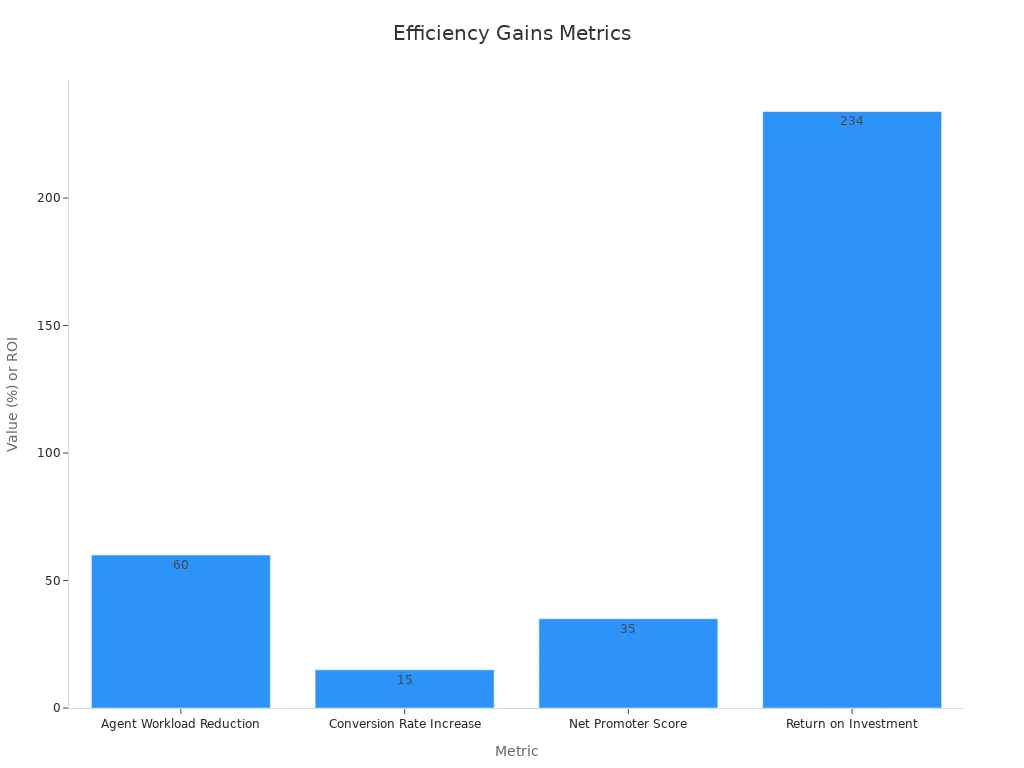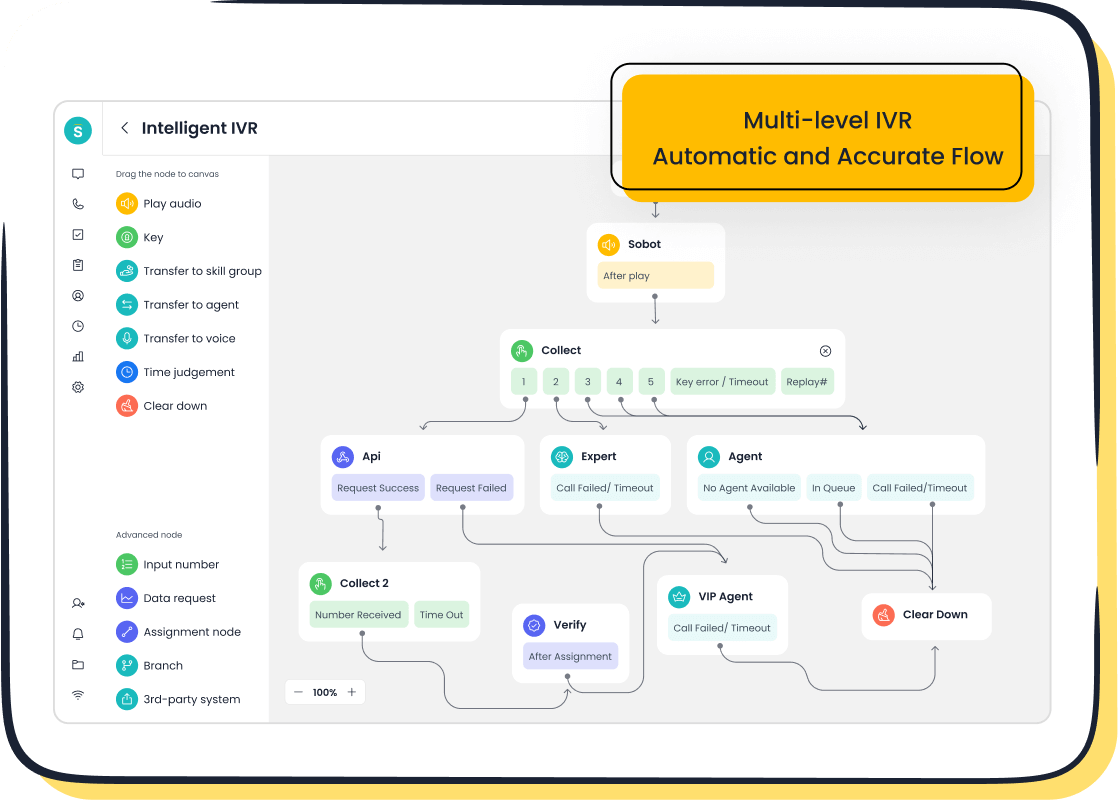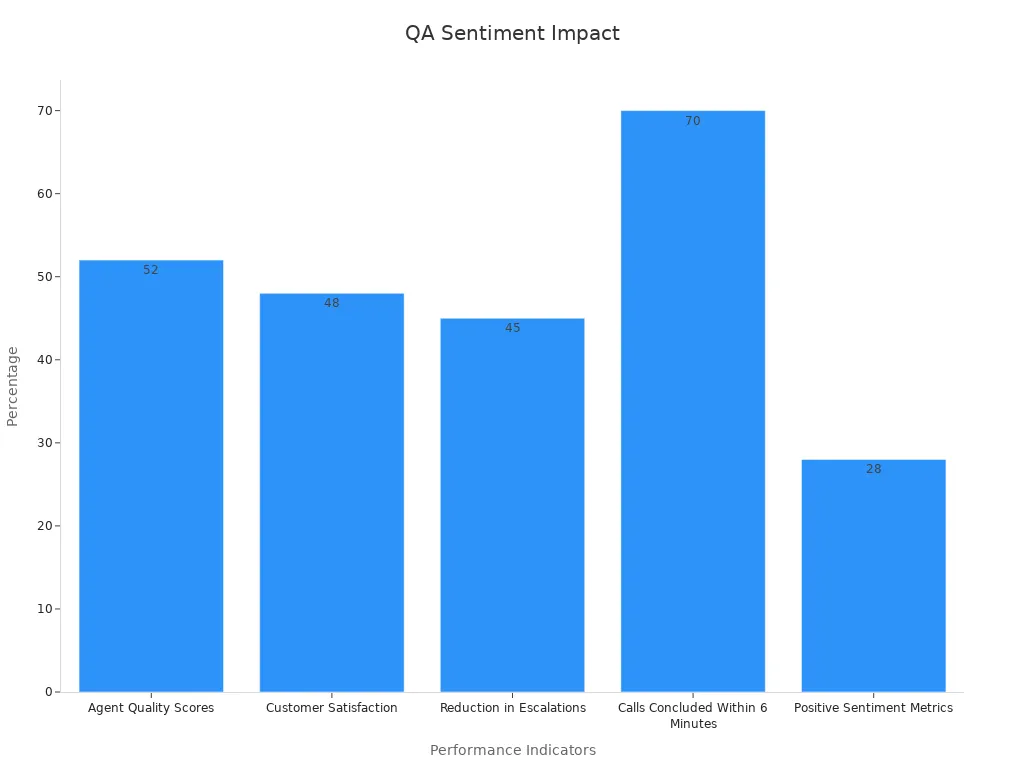Unlock Real-Time Sentiment Analysis for Your Contact Center

You can unlock real-time contact center sentiment analysis by leveraging advanced AI tools like Sobot AI. This powerful technology helps you understand customer emotions during every call or chat, transforming how you manage contact center operations and enhancing the overall customer experience.
- Predictive analytics and AI-driven insights from Sobot increase call center productivity by nearly 60%.
- Enhanced contact center sentiment analysis can boost topline revenues by up to 20%.
- Direct language analysis through Sobot AI replaces traditional surveys for more accurate customer satisfaction tracking.
Sobot provides solutions that deliver quick results and measurable improvements. The benefits extend beyond individual interactions, reducing agent workload and increasing conversion rates.

Contact Center Sentiment Analysis Overview

What Is Sentiment Analysis?
Sentiment analysis helps you understand how customers feel during every interaction. You can use this technology to collect data from calls, chats, and emails. It works by turning spoken words into text and then analyzing the words to find out if the customer feels happy, neutral, or upset. Sentiment analysis gives you a sentiment score for each conversation. This score shows if the customer had a positive, neutral, or negative experience. By looking at these scores, you can spot trends and see where your team needs to improve.
You can use sentiment analysis to:
- Find out what makes customers happy or frustrated.
- Track how well your agents handle different situations.
- Get early warnings about problems before they grow.
- Improve scripts and training for your team.
Sentiment analysis transforms raw data into insights that help you make better decisions in your contact center.
Why Real-Time Matters
Real-time analysis lets you see customer emotions as they happen. You can respond quickly to negative feedback and solve problems before they get worse. For example, if a customer is upset about a late delivery, you can step in right away and turn a bad experience into a good one. Real-time sentiment analysis also helps you coach agents during calls and lower customer churn rates. You can use it to spot urgent issues, reduce costs, and keep your customers happy.
Some benefits of real-time sentiment analysis include:
- Instant guidance for agents.
- Faster problem resolution.
- Better customer experience and loyalty.
- Improved agent performance and lower churn.
Sobot’s Approach
Sobot uses advanced AI and machine learning to power contact center sentiment analysis. You get features like speech-to-text transcription, automatic categorization, and agent performance scoring. Sobot’s platform collects sentiment scores from every interaction, helping you track trends and improve service. You can monitor all channels, including calls, chats, and emails, in one place. Sobot’s contact center solution gives you the tools to personalize support, automate routine tasks, and make data-driven decisions. This approach helps you deliver a better customer experience and manage your contact center more efficiently.
Benefits of Sentiment Analysis Software
Proactive Support
You can use sentiment analysis software to deliver proactive support in your contact center. This technology helps you spot customer issues as soon as they arise. Intelligent call routing uses sentiment analysis to connect customers to the right agents, which reduces call transfers and wait times. Real-time AI assistance gives your agents instant suggestions and information, so they can respond quickly and effectively.
The James Villas case study shows how sentiment analysis can identify and prioritize urgent customer issues. By tagging and routing urgent tickets, the company reduced resolution time by 51%. This means you can solve problems faster and keep customers happy.
With sentiment analysis, you do not have to wait for negative customer feedback or rely only on surveys and feedback forms. You can act before small issues become big problems.
Personalized Interactions
Sentiment analysis software lets you personalize every customer interaction. You can understand emotions and expectations by analyzing each sentiment score. This helps you tailor your responses and services to fit each customer’s needs. Companies like Yum Brands have used sentiment analysis to boost purchases and reduce churn through AI-driven marketing campaigns. McKinsey reports that AI-powered personalization can increase revenue by up to 15%. By 2025, retailers using personalized experiences may see up to 40% more revenue than those who do not.
You can use sentiment analysis to detect frustration or satisfaction, then adjust your approach in real time. This leads to higher customer satisfaction and loyalty. You can also improve product development by learning what features customers want from their feedback.
Operational Insights
Sentiment analysis software gives you valuable operational insights. You can track key metrics such as First Call Resolution (FCR), Average Handle Time (AHT), Customer Satisfaction Score (CSAT), and Net Promoter Score (NPS). Real-time sentiment analysis helps agents respond better by providing immediate insights into customer emotions. Speech analytics can detect emotional cues and monitor agent performance, which leads to higher quality scores.
- First Call Resolution (FCR): Solve issues on the first call, reducing callbacks.
- Average Handle Time (AHT): Lower the time spent per call by addressing inefficiencies.
- Customer Satisfaction Score (CSAT) and Net Promoter Score (NPS): Improve these scores by responding to emotions quickly.
- Average Speed of Answer (ASA): Answer calls faster with better resource management.
- Call Abandonment Rate: Reduce dropped calls by managing queues more efficiently.
You can use dashboards and reports to make timely adjustments and optimize your contact center. Sentiment analysis software helps you predict call volumes, identify bottlenecks, and schedule agents more effectively. This leads to continuous improvement in your contact center sentiment analysis strategy.
Enable Sentiment Analysis in Your Contact Center
Unlocking sentiment analysis in your contact center starts with a clear plan. You need to follow a few important steps to make sure you get the best results. Here’s how you can enable sentiment analysis and improve your customer service.
Data Collection and Integration
First, you need to collect data from every customer interaction. This includes calls, chats, emails, and even social media messages. You should connect all your communication channels to one system. This makes it easier to gather and analyze information.
Many platforms now offer strong integration features. For example:
- Some tools achieve 100% intent recognition and score every interaction, so you never miss important feedback.
- Platforms like AmplifAI offer over 150 native integrations. These connect speech analytics, QA, CRM, surveys, and even spreadsheets into one AI-ready layer.
- With these integrations, you can remove data silos and give your team a single view of all customer conversations.
When you use speech analytics in your contact center, you can save up to 30% in costs and see a 10% boost in customer satisfaction. This shows how important it is to have the right data collection tools in place.
Tip: Make sure your system can tag and categorize calls automatically. This helps you find trends and coach agents more effectively.
Speech-to-Text and NLP
Once you collect the data, you need to turn spoken words into text. Speech-to-text technology does this job. After that, Natural Language Processing (NLP) analyzes the text to find out how the customer feels.
Modern speech-to-text and NLP tools reach accuracy rates between 80% and 90% when conditions are good. These tools handle different accents and speech patterns well. NLP algorithms look at context, intent, and emotion. Data scientists keep improving these systems, so they get better over time. This means you get more accurate results than with manual tagging or basic keyword tools.
Note: Always use up-to-date speech-to-text and NLP models. Regular updates help your sentiment analysis stay accurate as language changes.
AI Powered Sentiment Analysis
Now, you can use ai powered sentiment analysis to process large amounts of data quickly. These AI models can review thousands of conversations in minutes. For example, GPT-4 can reach up to 93% accuracy in classifying customer emotions. Even smaller models like Llama 2 perform well, with about 91% accuracy.
In real-world cases, banks and other big companies use AI chatbots to handle millions of interactions each year. These bots answer simple questions in seconds and work around the clock. This frees up your agents to focus on more complex issues. Customer satisfaction scores often rise when you use AI to support your team.
Tip: Train your AI models with your own data. This helps the system understand your customers better and improves the accuracy of your sentiment analysis.
Real-Time Monitoring
Real-time monitoring lets you see customer emotions as they happen. You can spot problems right away and help your agents respond faster. Real-time analysis tools give you live feedback, so you can coach agents during calls.
Key features of real-time monitoring include:
- Immediate detection of changes in customer mood or agent performance.
- Live feedback and coaching for agents.
- Supervisor dashboards for instant intervention.
- Soft-skill scoring, such as empathy and rapport.
- Performance scorecards and compliance tracking.
Important metrics to watch:
- First Response Time (FRT): How fast you answer customers.
- Average Resolution Time (ART): How quickly you solve problems.
- Customer Emotional Intensity: How strong the customer’s feelings are during the call.
With these tools, you can improve agent performance, reduce handling time, and increase customer satisfaction.
Note: Use real-time monitoring to catch issues early. This helps you fix problems before they affect more customers.
Sobot Voice/Call Center Integration

To get the most from sentiment analysis software, you should integrate it with your Sobot Voice/Call Center platform. Sobot makes this easy with seamless integration and a unified workspace. You can manage calls, chats, and customer data all in one place.
Sobot’s system offers:
- Intelligent IVR for routing calls to the right agent.
- Real-time monitoring and analytics.
- AI-powered voicebots for instant customer support.
- Secure, encrypted data transfer.
- Global number availability and mobile compatibility.
You can track every interaction and use ai powered sentiment analysis to score calls and agent performance. Sobot’s platform supports real-time analysis, so you always know how your customers feel.
Tip: Regularly review your sentiment analysis results. Use these insights to train agents, improve scripts, and adjust your service strategies.
Step-by-Step Checklist for Seamless Implementation
- Evaluate your current contact center tools and data sources.
- Integrate all communication channels into one platform, like Sobot Voice/Call Center.
- Set up speech-to-text and NLP tools for accurate transcription and analysis.
- Train your AI models with your own customer data.
- Enable real-time monitoring and feedback for agents and supervisors.
- Track key metrics such as FRT, ART, and customer sentiment scores.
- Review and update your sentiment analysis process regularly.
Remember: Continuous improvement is key. Keep monitoring your results and adapt your strategies to get the best outcomes.
By following these steps, you can unlock the full power of sentiment analysis in your contact center. You will see better agent performance, faster problem resolution, and higher customer satisfaction.
Use Cases for Contact Center Sentiment Analysis

Live Agent Assistance
You can empower your agents with real-time sentiment analysis. When you use AI tools, agents see customer emotions as they happen. This helps them adjust their approach and solve problems faster. For example, real-time insights can reduce average handle time by 30% and boost customer satisfaction by 20%. Agents also get instant suggestions for responses, which leads to a 14% increase in productivity. Newer agents benefit even more, with a 34% productivity jump. You help your team focus on what matters most—making every customer feel heard and valued.
- AI sentiment analysis automates tagging and analysis of conversations.
- Agents receive actionable insights and performance tracking.
- Automation workflows let agents focus on urgent or negative cases.
Escalation and Alerts
Sentiment analysis helps you spot issues before they grow. The system flags calls with high negative sentiment, so you can act quickly. Real-time emotion detection gives agents feedback about customer mood, letting them adjust their tone or escalate the call. You can also use predictive analytics to plan for busy times and make sure urgent calls get attention. This approach improves first-call resolution and reduces handling times.
- Sentiment scores prioritize calls for immediate attention.
- Alerts help agents respond empathetically or escalate to supervisors.
- Analysis of speech patterns detects agitation and prompts calming responses.
Quality Assurance
You can improve quality assurance by adding sentiment analysis to your review process. The system tracks emotional cues and helps you measure how well agents connect with customers. Real-time feedback lets you coach agents right away. You can set custom KPIs that match your goals and use sentiment data to guide training.
| Quality Assurance Indicator | Improvement Highlight | Description |
|---|---|---|
| Agent Quality Scores | 52% improvement | Granular analysis for targeted coaching and feedback. |
| Customer Satisfaction | 48% improvement | Better engagement and reduced negative sentiment. |
| Reduction in Escalations | 45% reduction | Targeted training lowers escalation rates. |
| Calls Concluded Within 6 Minutes | 70% improvement | Faster resolutions linked to sentiment-driven coaching. |
| Positive Sentiment Metrics | 28% improvement | More positive customer interactions and satisfaction. |

Customer Satisfaction Tracking
You can track customer satisfaction in real time with sentiment analysis. The system measures emotions during calls, chats, and surveys. This lets you tailor your responses and improve service quality. By watching sentiment trends, you find common concerns and train your staff to address them. Continuous monitoring helps you make quick changes, which leads to higher satisfaction and loyalty.
- Real-time emotional insight leads to more meaningful interactions.
- Sentiment trends support targeted staff training.
- Continuous monitoring enables proactive service adjustments.
Sobot Customer Story: Agilent
Agilent, a leader in life sciences, used Sobot’s solution to transform its contact center. By integrating AI-powered sentiment analysis, Agilent increased operation efficiency sixfold and cut service costs by 25%. The company reached a 95% customer satisfaction score. Sobot’s chatbot handled routine questions, so human agents could focus on complex issues. Intelligent routing matched customers to the right experts. Agilent unified all channels—website, social media, and shopping platforms—on one platform. The system tracked over 300 metrics for ongoing improvement.
| Performance Aspect | Details |
|---|---|
| Operation Efficiency Increase | 6 times (sixfold) increase in customer service operation efficiency |
| Cost Reduction | 25% reduction in overall customer service costs |
| Customer Satisfaction (CSAT) | Reached 95% |
| Service Availability | 24/7 zero-latency service via AI-powered chatbot |
| AI and Human Agent Integration | Chatbots handle routine inquiries; human agents focus on complex issues |
| Intelligent Routing | Automatic matching of customers to specialized skill groups |
| Omnichannel Communication | Unified platform integrating website, social media, and shopping platforms |
Sobot’s impact shows how sentiment analysis can drive real results in any contact center.
Best Practices and Challenges
Data Privacy and Security
You need to protect customer data when using sentiment analysis in your contact center. As more centers use AI to understand emotions, the risk of data leaks grows. In 2024, 33% of centers use sentiment analysis, and this number will rise to 74% by 2026. Security tools like voice authentication are also becoming more common. You should use strong security, such as multi-factor authentication and 256-bit encryption, to keep call recordings safe. Many customers leave brands that do not handle data well. Following rules like GDPR, CCPA, HIPAA, and PCI DSS is not just smart—it is required. Automated compliance tools help you manage these rules and keep customer trust.
Multilingual Support
You serve customers from many backgrounds, so your sentiment analysis must work in different languages. AI-powered translation tools help you understand emotions in every language. You can measure success by looking at:
- Conversion rates by language and region
- Customer satisfaction scores for each language group
- Response times in different languages
- Retention rates linked to native language support
- How well sentiment analysis detects emotions across languages
- The ability of AI to understand context and cultural nuance
These metrics show if your system meets the needs of all customers, not just those who speak one language.
Staff Training
Your team needs training to use sentiment analysis tools well. Good training programs teach staff how to read customer data and improve engagement. You should check their skills with real conversations and give feedback often. Ongoing training helps your team stay sharp and ready for new challenges. Focus on skills like active listening, content engagement, and solving problems. Regular reviews and coaching help your staff meet customer expectations and deliver better service.
Continuous Improvement
You should always look for ways to make your sentiment analysis better. Start by tagging keywords in conversations and checking the emotional tone. Find trends and common issues, then use these insights to make changes. After you act, watch the results and adjust as needed. This feedback loop leads to steady improvement.
- Tag keywords in interactions.
- Analyze sentiment for emotional tone.
- Spot trends and themes.
- Make recommendations based on insights.
- Monitor changes and repeat the process.
A table can help you track progress:
| Benchmark Category | Metrics / Examples | Role in Improvement |
|---|---|---|
| Customer Engagement | CSAT, NPS, FCR, AHT | Shows how sentiment analysis boosts satisfaction |
| AI and Automation | Chatbot FCR, skills-based routing | Measures automation success |
| Omnichannel | Phone, email, chat, SMS, social media benchmarks | Validates effectiveness across all channels |
You can use surveys and feedback forms to compare results and find new areas for improvement. This approach keeps your contact center moving forward.
You can unlock real-time sentiment analysis by following clear steps: collect data, use AI tools, and monitor results. This approach improves customer service and boosts business outcomes.
- The contact center software market may reach $75.5 billion by 2025, driven by AI and demand for better experiences.
- AI can resolve up to 65.7% of inquiries and increase agent productivity by 87%.
- Speech analytics and sentiment analysis are now vital for modern call centers.
Explore Sobot’s solutions to stay ahead. Keep evaluating your process and adapt as technology grows. Start your journey today and transform your contact center experience.
FAQ
What is contact center sentiment analysis?
Contact center sentiment analysis helps you understand customer emotions during calls, chats, and emails. You can use this tool to track how customers feel and improve customer experience. It gives you a sentiment score for each interaction, making it easier to spot trends and areas for improvement.
How does real-time analysis help my team?
Real-time analysis lets you see customer emotions as they happen. You can respond quickly to negative customer feedback and coach agents during calls. This approach improves customer satisfaction and helps your team deliver better service every day.
Can sentiment analysis software replace surveys and feedback forms?
Sentiment analysis software gives you instant insights from real conversations. You do not have to rely only on surveys and feedback forms. You get a more accurate view of customer experience and can make changes faster for continuous improvement.
How do I use ai powered sentiment analysis for improvement?
You can use ai powered sentiment analysis to review thousands of interactions quickly. This tool helps you find patterns in customer feedback and track sentiment scores. You can use these insights to train agents, adjust scripts, and boost customer satisfaction.
See Also
Best Speech Analytics Solutions For Call Centers In 2024
Leading Call Center Analytics Platforms To Use In 2024
Best Cloud-Based Contact Center Services Reviewed For 2024
